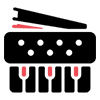The black and white Technological Marvel
The keyboard is a gateway to musical expression, blending melody, harmony, and rhythm in a single instrument. Whether you’re aspiring to play classical compositions, compose electronic beats, Learning Keyboard lessons Online – following your passion or simply enjoy the joy of creating music, the keyboard is a versatile and accessible choice. Its ability to mimic the grandeur of a piano or the futuristic sound of a synthesiser makes it an ideal starting point for any budding musician. This guide will help you make an informed decision by covering the key factors to consider.
Does Size Matter?
First among many things, it is essential to understand your functional use of the keyboard. Factors like: what and where you are using your keyboard for, how many keys do you need, how big or small you want the keyboard to be , for purpose of mobility and travel.When purchasing a keyboard, size plays a crucial role in determining the instrument’s versatility and ease of play.
Keyboards come in various sizes, typically ranging from 25, 49, 61, 76, to 88 keys.
- A 25 or 49-key keyboard is compact and great for beginners, producers, or those with limited space.
- The 61-key variant is a balanced option for learners and stage performers who need portability without compromising too much range.
- A 76-key keyboard provides extended octaves, catering to intermediate and advanced players.
- For those seeking the feel of an acoustic piano, an 88-key weighted keyboard is the ideal choice, offering the full range and expressive touch.
Along with size, consider key action (weighted, semi-weighted, or synth-action), sound quality, polyphony, and additional features like MIDI connectivity and built-in sounds. Choosing the right keyboard depends on your playing style, space constraints, and long- term musical goals.
Understanding Key Action And Sensitivity
When purchasing a keyboard as a beginner, key action and sensitivity are crucial factors to consider. Key action refers to how the keys respond when pressed—synth-action keys are lightweight and easy to play, making them ideal for young learners or producers. Semi- weighted keys offer a bit more resistance, bridging the gap between digital and acoustic pianos.
For those aiming to transition to a real piano, fully weighted or hammer-action keys closely mimic the feel of an acoustic piano, providing a more authentic experience. Key sensitivity, or velocity sensitivity, determines how the keyboard responds to touch— pressing harder produces a louder sound, while a lighter touch results in a softer note.
Beginners should opt for a keyboard with at least velocity-sensitive keys, ensuring dynamic control over their playing. Choosing the right key action helps develop proper technique and enhances the learning experience from the start.
Velocity sensitive can play a major role in adding texture and emotion to your music.
Exploring Inbuilt Sound Banks and Features
When selecting a keyboard, the inbuilt sound bank and additional features play a significant role in enhancing the learning experience.
Most beginner-friendly keyboards come with a variety of instrument tones, such as pianos, strings, organs, synths, and percussion, allowing players to explore different sounds.
Brands like Casio and Yamaha offer entry-level models with high-quality sampled sounds, while Roland and Korg provide richer tones and effects suited for more expressive playing. Some keyboards also include accompaniment styles, rhythm patterns, and learning modes to help beginners practice.
Features like MIDI connectivity, recording functions, and built-in metronomes add value, aiding both practice and composition. While purchasing, consider the sound quality, number of tones, polyphony (minimum 32-64 notes for smooth transitions), and connectivity options. A well-equipped keyboard not only makes learning more engaging but also supports long-term musical growth.
Understanding Keyboard Connectivity, Sound Processing, and Accessories for an Enhanced Playing Experience
Modern keyboards offer a wide range of connectivity options, making them versatile for both beginners and professionals.
- USB-MIDI and traditional 5-pin MIDI ports allow users to connect their keyboards to DAWs (Digital Audio Workstations) for recording and music production. Some advanced models even feature Bluetooth MIDI, enabling wireless connectivity with tablets or smartphones for app- based learning and performance control.
- Audio output options like stereo line outs, headphone jacks, and USB audio interfaces are essential for live performances and studio setups. Additionally, pedal inputs for sustain and expression control add depth to playing, while SD card slots and USB storage enable easy data transfer and sound expansion.
- The sound engine and sequencing capabilities of a keyboard determine its creative potential. Keyboards with PCM-based sound engines (used in brands like Casio and Yamaha) provide high-quality sampled sounds, while synth engines(like Roland’s SuperNATURAL or Korg’s AL-1) offer deep sound shaping and customization. Workstations and arranger keyboards come with built-in sequencers, allowing users to record, edit, and layer tracks directly on the keyboard, making them perfect for composers and performers. Features like arpeggiators, loop recording, and DSP effects help enhance musical creativity, while auto-accompaniment and chord recognition assist beginners in developing their playing skills.
- A well-designed user interface and accessories further improve the playing experience. Beginner keyboards typically feature simple LCD screens and dedicated function buttons, whereas professional models include touchscreens, assignable knobs, sliders, and touchpads for deeper control. Backlit keys and customizable controls help performers navigate settings easily during live shows.
- Essential accessories like adjustable stands, sustain pedals, padded gig bags, and external power adapters ensure comfort and portability. Whether choosing a basic learning keyboard or a high-end synthesizer, considering connectivity, processing power, user interface, and accessories will help players find the perfect instrument for their needs.
A comparative study of Keyboard brands, pricing and special features:
| Brand | Model | Keys | Price | Features | Best For | Key Highlights |
|---|---|---|---|---|---|---|
| Casio | CT X9000IN | 61 | 22,995 INR | 800 tones, Indian rhythms, MIDI connectivity | Performers seeking diverse sounds | Lightweight, affordable, good learning tools |
| Yamaha | PSR I500 | 61 | 24,636 INR | 40 Indian instruments, 282 accompaniment styles, ‘Riyaz’ function with 30 Taals | Beginners and Indian music enthusiasts | Good sound quality, durable, ideal for beginners |
| Yamaha | E403 | 61 | 15,650 INR | Portable, built-in 2-way speakers, USB connectivity, Auto chord, note sync, 425 tones | Best for beginners | Good sound quality and easily portable |
| Yamaha | P-145 | 88 | 48,190 INR | Graded Hammer Standard (GHS) keyboard, realistic piano tones, compact design | Best for beginners and intermediate learners | Good sound quality and easily portable |
| Roland | EX10 | 61 | 17,250 INR | 600+ tones, built-in stereo speakers, AUX input, Save mode, auto accompaniment | Best for beginner and intermediate learners | Superior key feel, better for long-term learning |
| Roland | FP 10 | 88 | 49,500 INR | SuperNATURAL piano sound, PHA-4 Standard keyboard, Bluetooth connectivity | Performers who desire a pianist experience | Superior key feel, better for long-term learning |
| Korg | EK 50IN | 61 | 37,500 INR | 40 Indian Styles and Sounds, 702 preset sounds, built-in 10W+10W speakers | Performers seeking diverse sounds | Great for performance & beginners exploring various styles |
Confusion or Conclusion? - depends on being correctly informed !!!
Being well-informed about keyboard brands and their features empowers beginners to make the right choice and invest in an instrument that suits their needs. When starting to learn to play the keyboard, it is essential to consider factors such as touch-sensitive or weighted keys, built-in learning tools, and USB/MIDI connectivity, as these can greatly enhance the learning experience.
Many beginner-friendly models come with interactive features that make keyboard lessons for beginners more engaging and effective. A well-chosen keyboard fosters motivation, helps build essential skills, and ensures a smoother transition to more advanced playing.
By researching and comparing different models, beginners can confidently embark on their musical journey with an instrument that supports their growth, creativity, and long-term development.
























